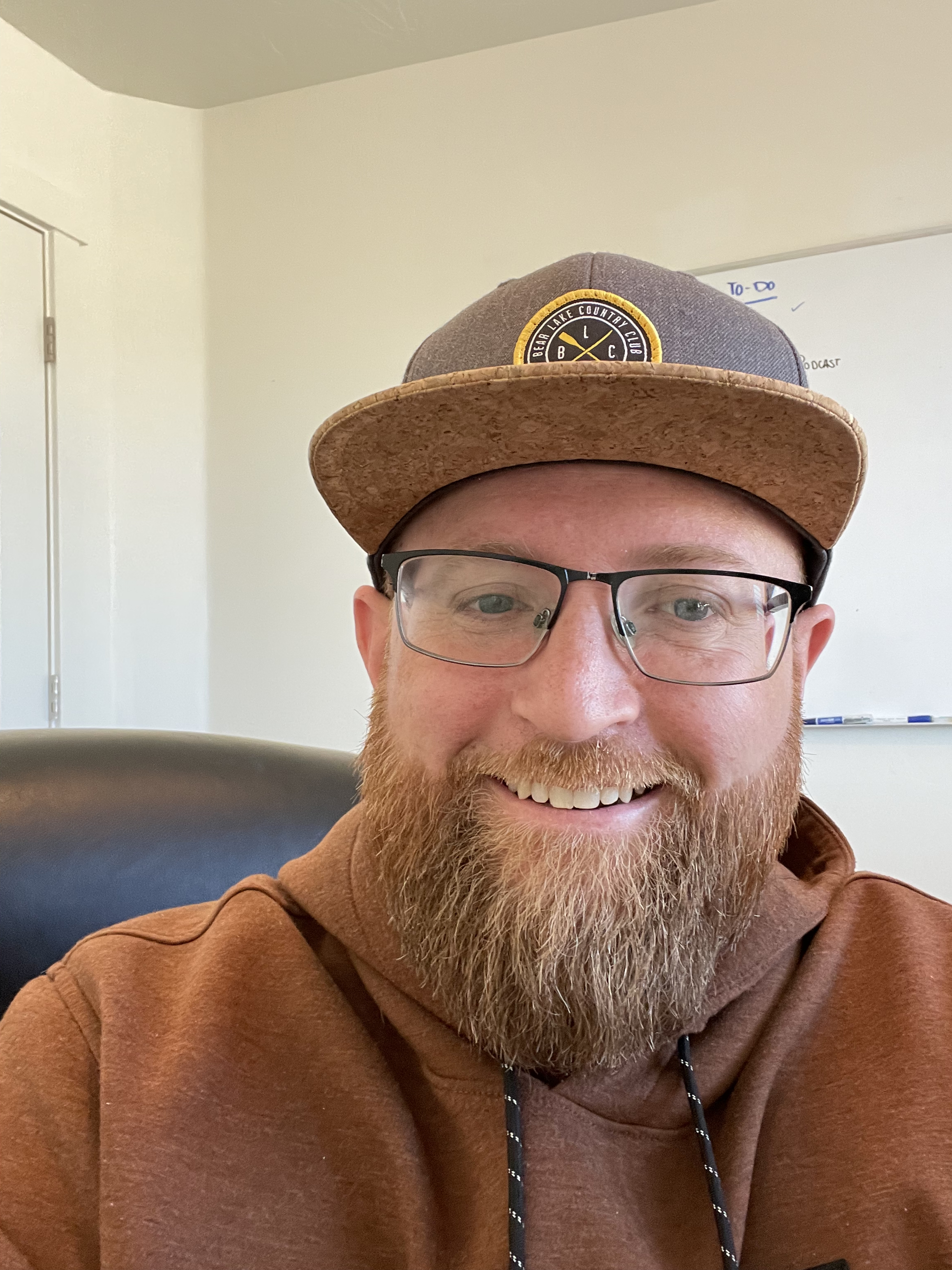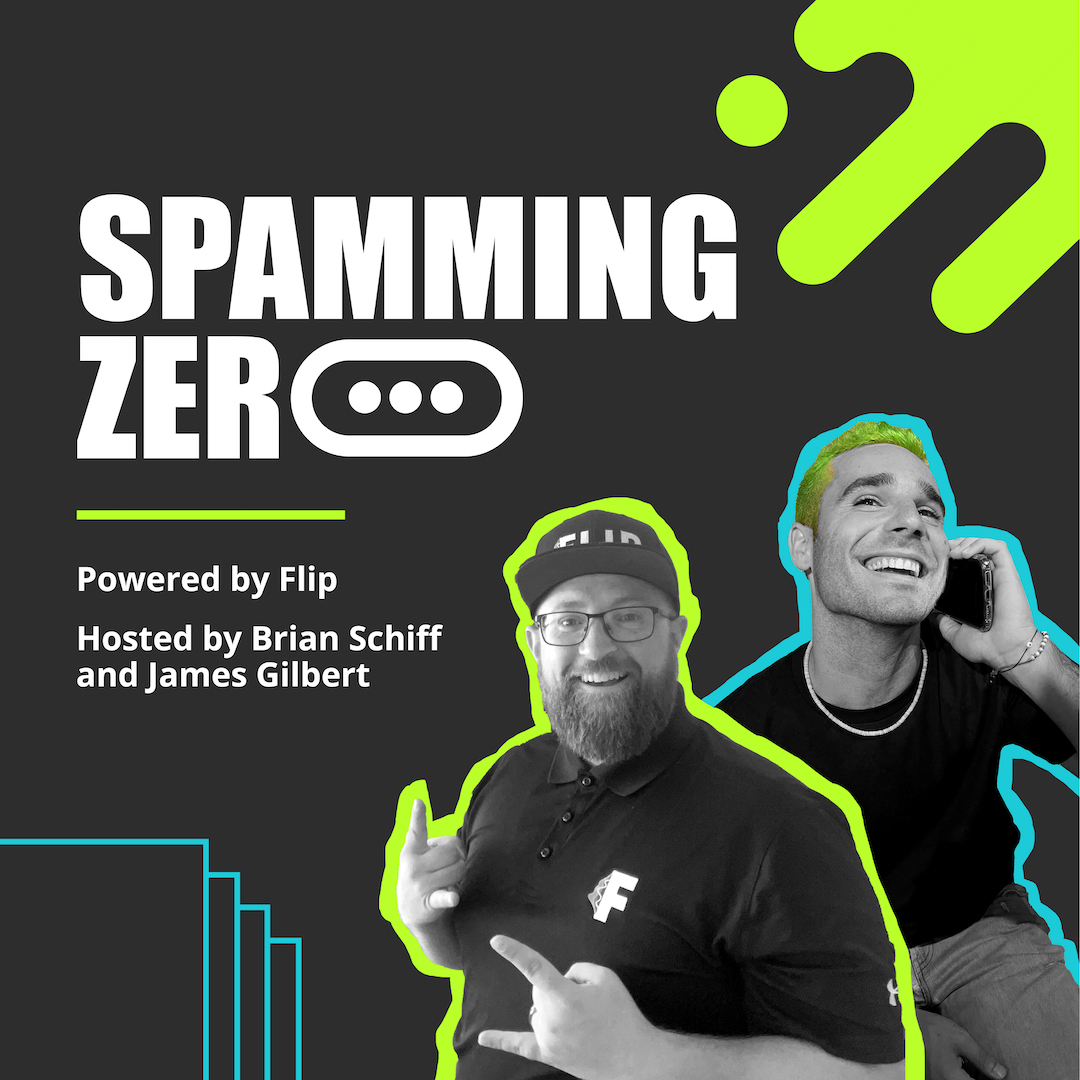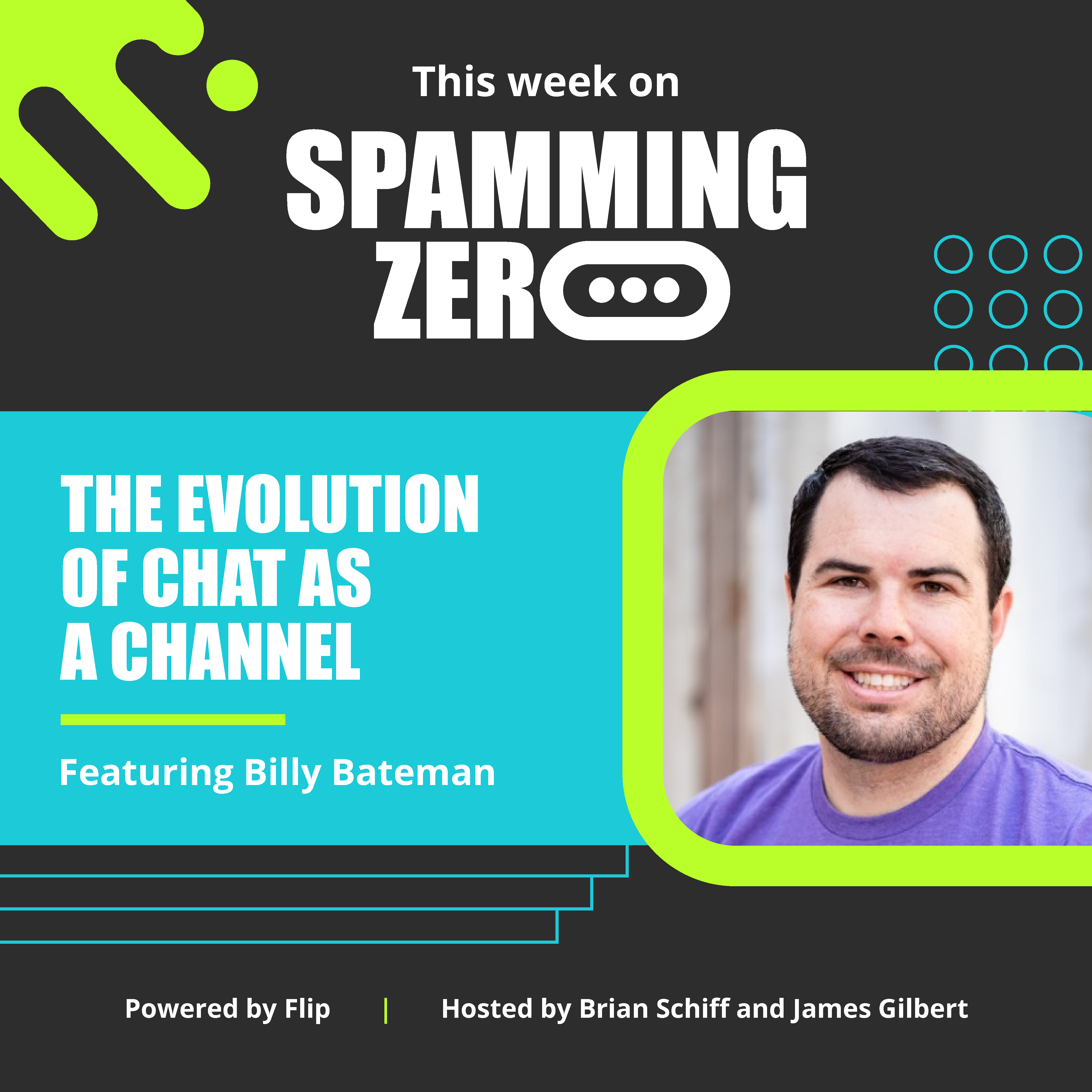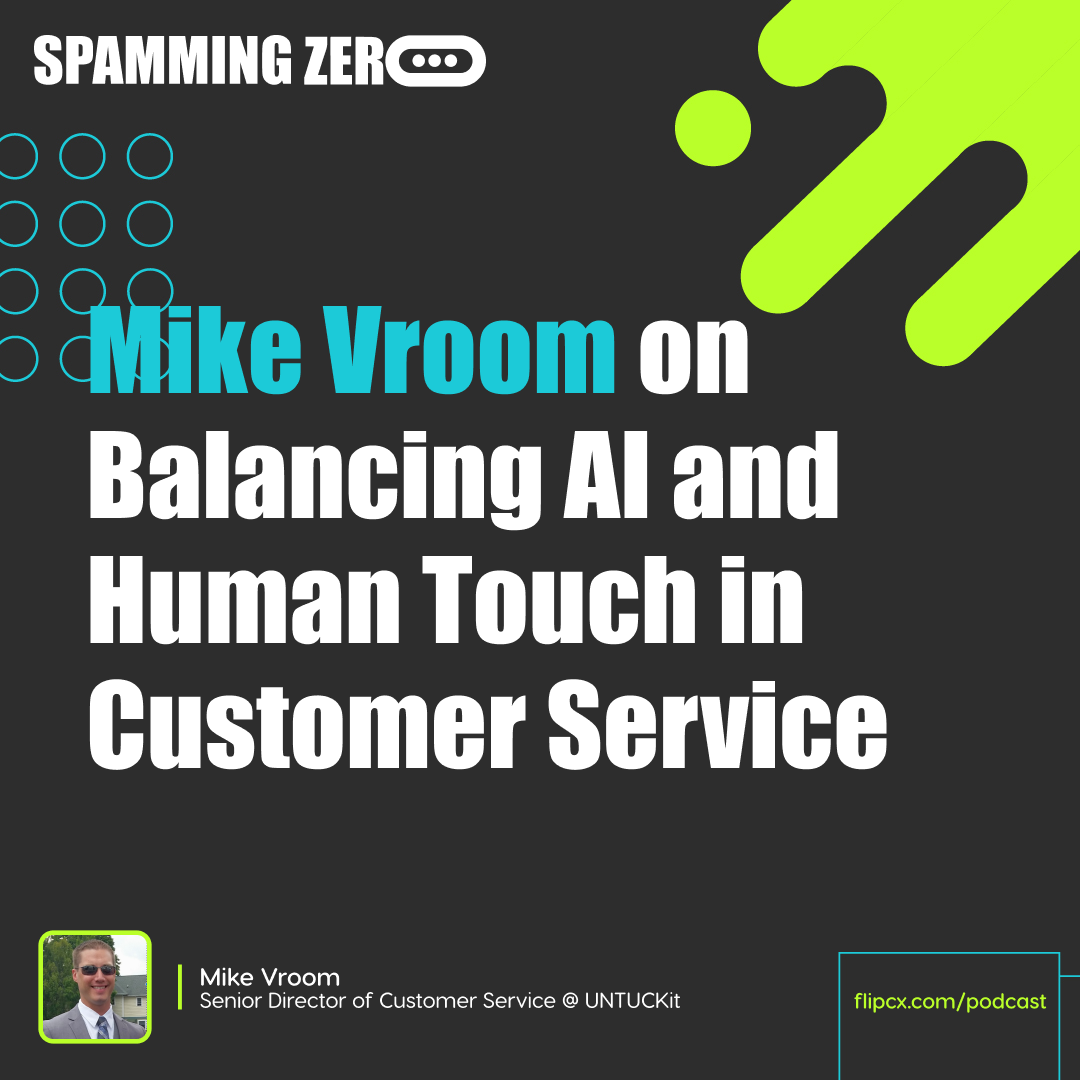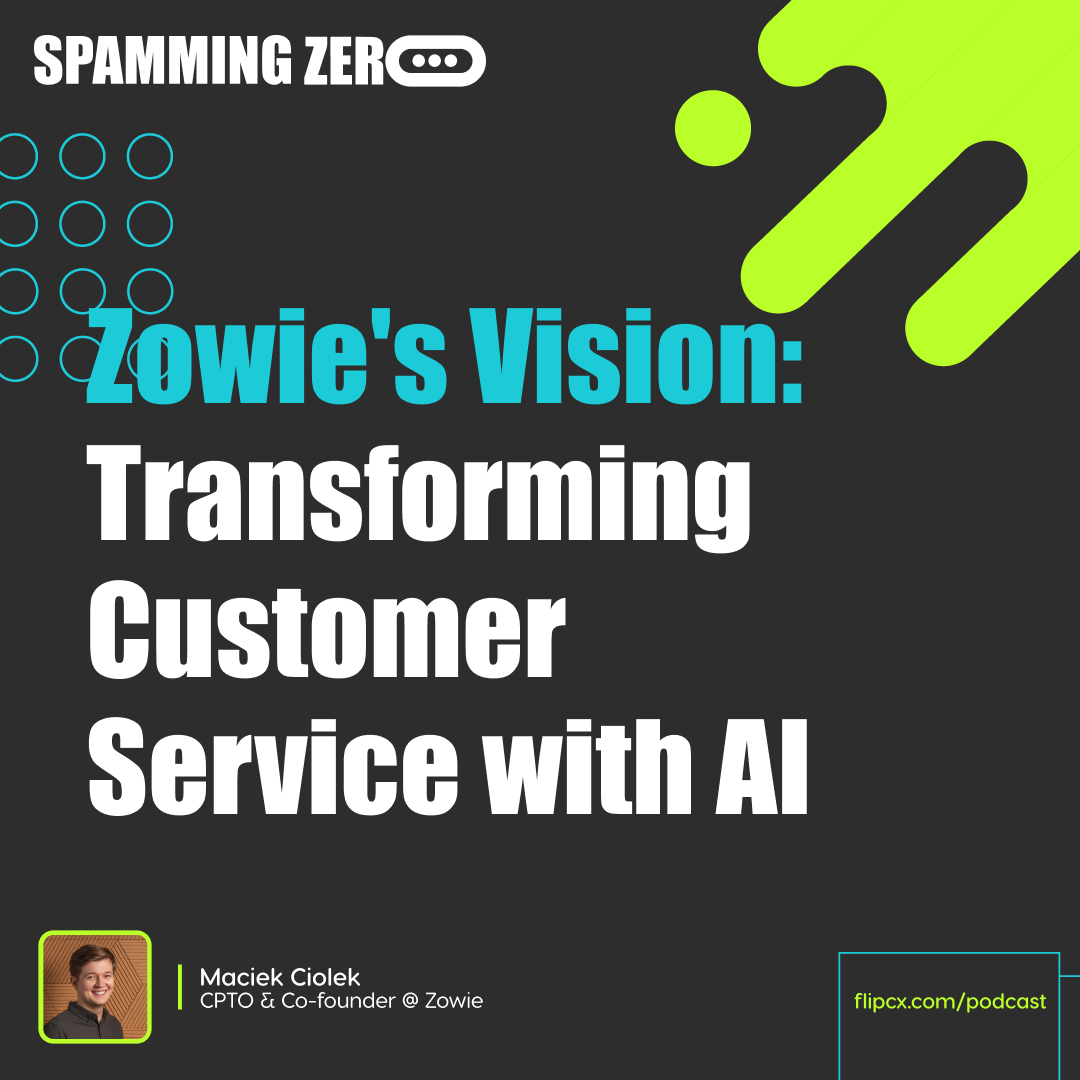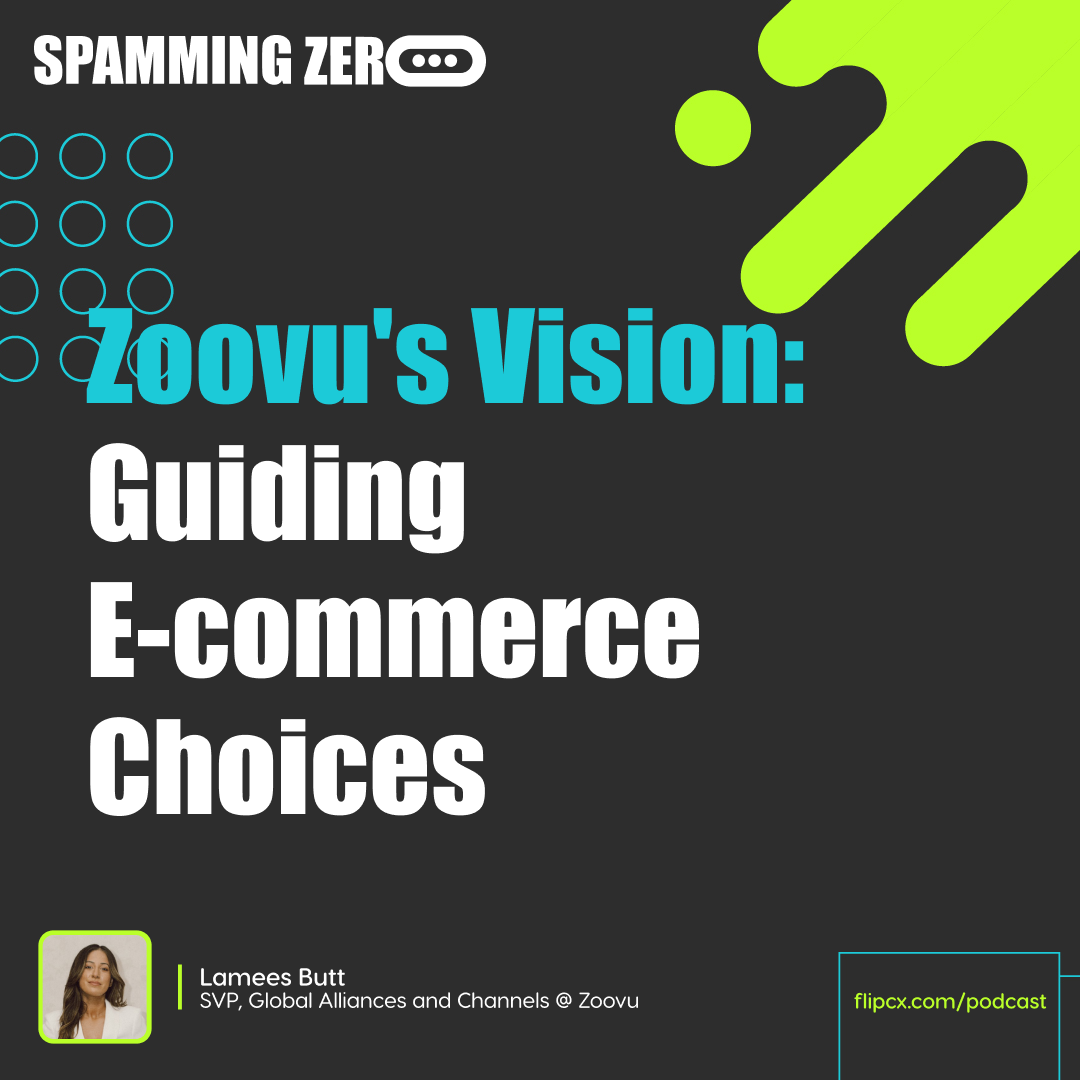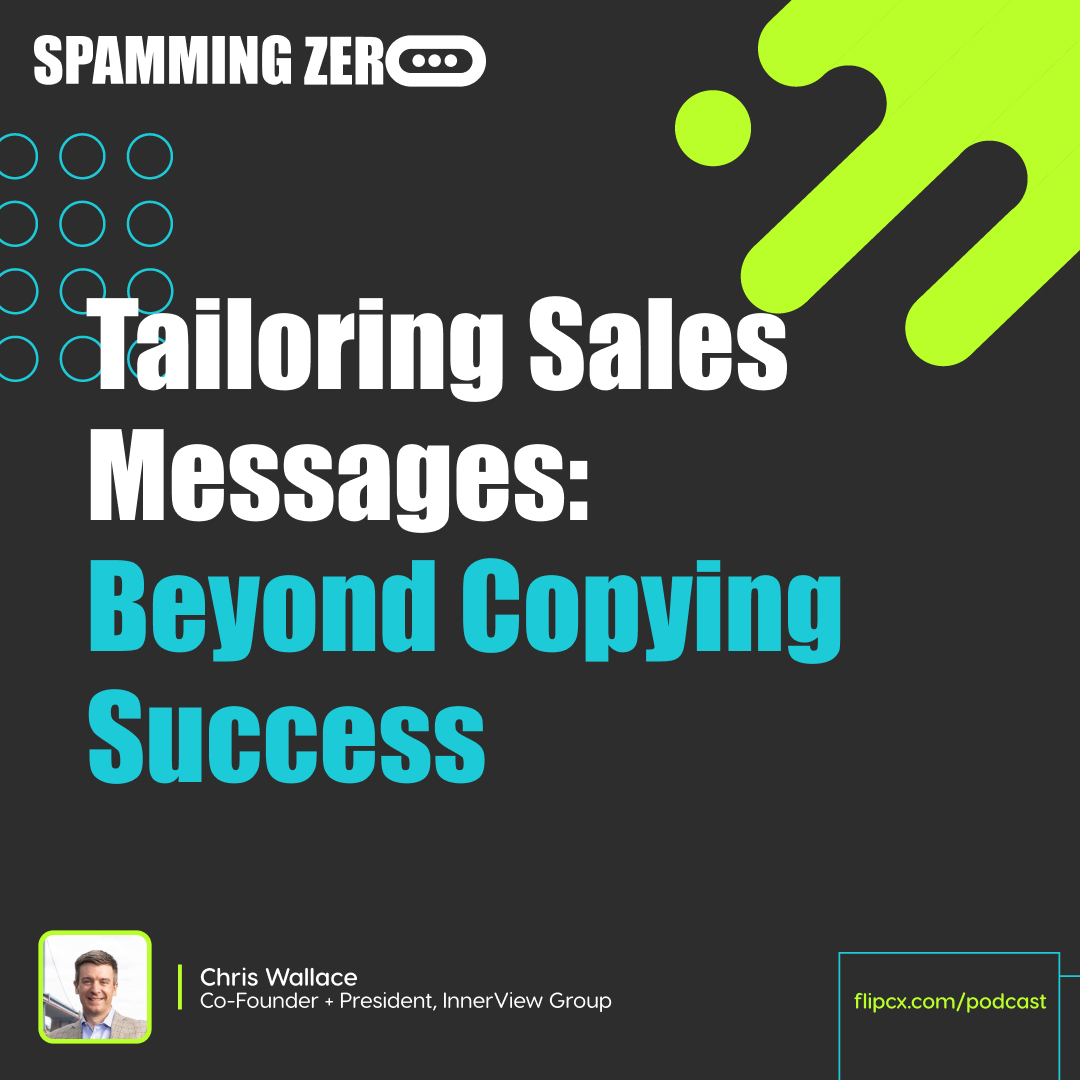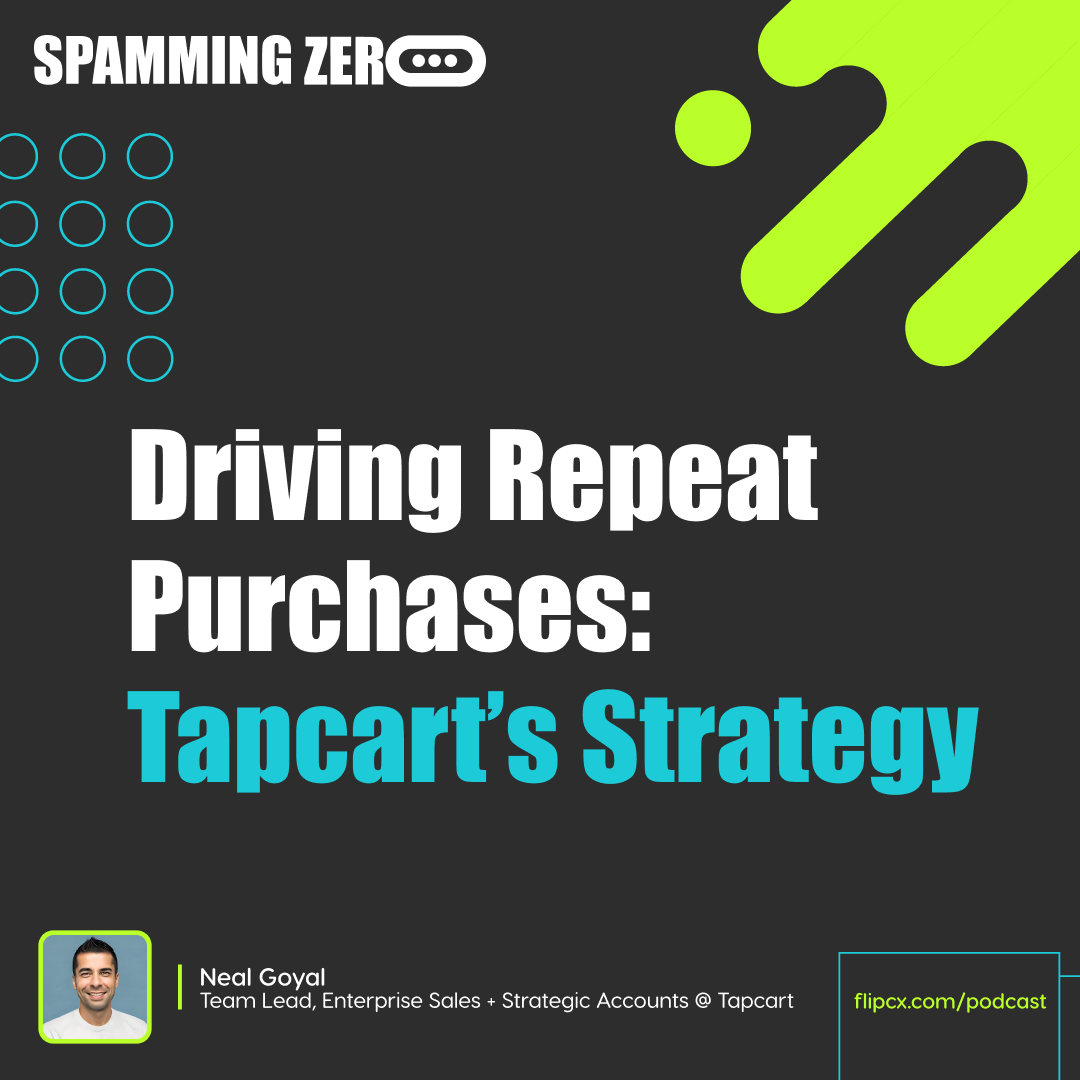Episode 35: The Evolution Of Chat As A Channel
- 0.5
- 1
- 1.25
- 1.5
- 1.75
- 2
James Gilbert: Hello and welcome to the show, Spamming Zero. I'm one of your hosts, James Gilbert. We're excited because this month's sponsor is brought to you by CXperts. If you need help with your digital experiences, especially when it comes to the customer experience overall and the strategies there, reach out to see CXperts. io. They're an incredible team and incredible people that work there. They believe in three pillars of customer experience. CX Insights better Understand how your users interact with your brand online, CX optimization, make improvements for your customers and your business goals, and then CX Launch, empower your team to make CX a part of your toolkit for success. They are the experts when it comes to customer experience and they would love to work with you. Again, CXperts. io. I'm James.
Brian: And I'm Brian.
James Gilbert: And this is Spamming Zero. Welcome to another episode of Spamming Zero, everyone. Today we're joined by Billy Bateman. Billy, welcome to the show.
Billy Bateman: Glad to be here guys.
James Gilbert: So Billy, Brian and I obviously are big fans of automation, in general. And chat has been at the forefront of automation for now quite a while. Let's unpack, the three of us, the evolution of this journey with chat. Talk to us a little bit about what you've seen being at now Signals, which was ChatFunnels. And just like the evolution that's happened there, what has been the one or two things that you think the market has really grasped onto and why it's been so successful in growing?
Billy Bateman: Yeah, so we started Signals, it was ChatFunnels at the time, in the summer of 2018. And what we saw at the time was Drift was just on a tear. Intercom was growing crazy. There were a few other tools. And to even go back before then, those guys were really starting to use automation, just real basic rules, engine chatbot. And before that we had, has anyone heard of Live Chat. They're this huge company.
James Gilbert: I remember them.
Billy Bateman: Yeah, yeah, they're still around.
James Gilbert: Yes they are.
Billy Bateman: But it was basically just live chat was all it was. Not much in the way of automation. Maybe one question to kind of filter you out. But I think around 2017, 2018, we saw this shift where, and that's where I really dove in was automation was beginning to work. I think when Drift put the calendar into the chatbot, that just blew everyone's mind for a little while. I think it was their secret sauce. It was the one thing they had for a while that nobody else had was, " Hey, we can book meetings right out of this chatbot." And the hard part was nobody knew how to run them. You would get set up with Drift, they would maybe help you build a bot or two and then just they're growing so fast that they'd just move on to the next customer, move on. And we came in as a consultancy and we started AB testing bots. And what I think we found that a lot of people started doing was realizing, you don't need, for a B2B sales and marketing, you don't actually need this AI bot. It's just a rules engine. People come to your site, they're looking to buy from you or not. You need to figure out how do I qualify them in a way that makes my sales team happy or my marketing team happy enough for an MQL and get them to the right person quickly, as well. That's what I really love about the bots, is it's an easy way to do a quick qualification and then get them connected to the right person or sent to the right place if it's not a person that they need to talk to. And I feel like the market has really grasped onto that in the last couple years, whereas five years ago people loved the idea but nobody knew how to execute very well.
James Gilbert: You basically created a new category for businesses. It was called chat and then it moved to I think conversational marketing and then it moved to conversational AI and now it's something different now. But ultimately, it's all around that conversation stuff. What's interesting is I remember being a early customer of Drift, way back in the day. I actually even think we used LivePerson. And so I was working at a tractor manufacturer called AGCO.
Billy Bateman: I love this story.
James Gilbert: This is a wild one. And you would not think that farmers would want to get on chat because they're not the most adaptable to technology. That's probably the nicest way to put it. And we had this idea that, you know what? That's not true. Farmers were accessing the websites more than ever before and we had products that could be sold directly online, like an e- commerce kind of play. And so we were like, " You know what? We're going to implement chat." And in order for this Fortune 500 company that I worked for, in order for them to be on board with it, they wanted me to test it out and run it. And I had never done this before. I had manned chat, gone on and been proactive with it and things like that. So I got this company called Lead Anywhere for a little while that helped us do chat directly in the website and I was manning the chats. And I sold one of the company's largest deals through chat. It was a massive deal. And these were not cheap things that we're selling. We're talking about$ 300,000 combines. You think a contract in B2B software is expensive, try buying a flipping combine, it's insanely expensive. And people were buying eight, nine of these at a time through chat. And so it really opened the organization's eyes up to the idea of our consumers, regardless of what walk of life they were, they were adopting technology online to be able to have some self- serve motions. And I think that idea of how where our consumption of content and education has gone from, we need to now have this be self- serve, that happened really, really fast. Almost too fast for the market to handle. Then businesses couldn't operate. And to your point, I have implemented so many chatbots over my career now if that's what we want to call them. And you're right, it is incredibly difficult to build out the flows if you're trying to automate those things, it's incredibly difficult to do. And I think it's the biggest challenge that exists in that particular area as it is a massive amount of work to build those out and build the logic out so that it makes sense. Because what you have is a critical moment of whenever somebody's in a chat, there is a moment of a brand experience that people are either going to have a good or bad one. And if they ask a question back to that chat and that wasn't thought of in your inquiries, it can leave them hanging, which can be a bad experience. So how do you think that the evolution of this particular industry is going to evolve over the next couple years?
Billy Bateman: I think over the next couple years, you're going to see more of the AI, especially as AI has gotten a lot better. I think you're going to see more of that coming in. And I think that's for sure, especially for the bigger companies. They're going to want to leverage that. They're going to have the budgets and the teams to do that. But the next thing is I think you're going to see more companies actually putting their sales reps and not just the BERs, like AEs, onto chat to engage with people really quick. What I see with our customers, I try to check in with all of our customers at least once a year. We're still at that phase where I can, which I love. And some of them, I see more frequent and get feedback from them. But our customers that are just absolutely killing it and generating the most pipeline and the most revenue, they're using the chatbot portion of our product to just engage people and filter out really quickly. But then as long as it's out the middle of the night, they're bringing their sales team in or their marketing team, whoever's assigned to chat, really quickly, to talk to people.
James Gilbert: It's the proactive engagement, it really gets people.
Billy Bateman: Yeah, we all want answers now and a lot of B2B is not self- serve in getting signed up and seeing will it work, and whether it's SaaS or selling equipment, whatever it is, you got to talk to a person to be comfortable moving forward. And the faster you can engage with people, the more likely you are to close the deal. That's not even unique to chat. I worked for inside sales for a while and we had this study that we did with, I think it was Kellogg Business School, that found if you contacted somebody within five minutes of them reaching out versus an hour, your chances of closing that deal went up 400%.
Brian: So you guys have a very specific segment of the market that you're going after, both in terms of an, and correct me if I'm wrong here, but focused on B2B SaaS companies and then really focused on leveraging chat top of funnel as a way of generating pipeline versus looking at down the buyer journey. There's whole companies that are built around using chat as a means of customer service for existing customers. And chat is obviously huge in the B2C realm as well. So when you think about the market landscape of chat stretching into all of these different segments, what was your guys' thought process around focusing in the way that you did and how do you make sense of what for an outsider looks like an incredibly crowded kind of market map at this point? How does it slice and dice for you?
Billy Bateman: We focus on the SMB, so like 50 employees to 250 is our sweet spot and then around the edges there as well. But we're pretty industry agnostic as long as it's B2B. And we've actually shifted away from the name change from ChatFunnels to signals was because we'd started building out our product because we realized chat is a great tactic and a great tool in your tool belt for growing revenue. It's not the whole solution. And we wanted to be a more holistic solution for our customers. So we built out essentially what we call now our Signal marketing, which is a combination of account- based engagement, conversational marketing and a little bit of intent in there as well. So we look at everything going on, on your website, we tell you which accounts are on there, what they're doing, roll everything up on the account level and then segment your accounts based on where they are in your customer journey. And our focus is on growing that top line revenue, but we have customers that use us through the whole customer life cycle. So if you're a customer of Signals and you come into the website and want to chat, my sales team is not even going to know that you were there because your CSM is going to get alerted and routed in if you need to talk to them, or at least notified that, " Hey Brian and James from Flip, they're on the site and they looked at these pages, they chatted into the bot and looked at these help docs to figure something out." So at least they know that's what's going on and they can even reach out to you and say, " Hey, saw this happen, do you have any more questions? Just want to make sure you're taken care of." So what we decided to do was not just go into chat and take a broader more holistic approach for our customers and being able to see how do you grow revenue, you got to think about those accounts on the site and then we'll even compliment with your buying committee members. If you come to the site and you don't engage but you show some intent and it matches your ideal customer profile, we'll give you that buying committee and let you reach out automatically through emails or drop them into your sales team's cadences.
Brian: So do you find that by focusing on top of funnel pipeline generation for B2B companies that the types of inquiries that come in and the types of flows that are needed end up being pretty consistent from one company to another?
Billy Bateman: Yeah. Overall, yes. But we started as a consulting company so we still have that in our DNA to where my CSM team, they're pretty hands- on with getting people set up and we'll start out with, okay, what are the best practices that generally work for whatever flow you're trying to work into? But then let's run some testing and see what actually works for each customer and adapt because that's really where you go from being a good solution to a great solution, is helping your customers fine tune it just for them.
James Gilbert: I think it's interesting because chat is what we would call our twin here at Flip. We do voice automation and then chat does a lot of the chat automation. And if you look at the projections and the trends that are projected to happen just in chat alone, so I'll give you some stats here. Back in 2017 through 2022, you saw a massive uptick that happened with the chat growth and in particular from 2020 to 2022, it was like 20 times the growth.
Billy Bateman: Yep.
James Gilbert: So let me repeat the years here. We all know what happened in 2020. And from 2020 to 2022, almost 20 times the growth in that particular industry. So one, I think a big reason is people are more adapt to going online than ever before. Consumers are there, we need to adapt to what they need and mean we're looking at projections of it going up even more in 2023. But going up even more to your point with AI integrated into it and also allowing voice to be integrated into it as well, which is what we're seeing. We're seeing the projected market of voice being equally as a growth opportunity, if not more. And one of the things that I have always been a big believer in is these channels, as I call them, and chat being one of them, they're a primary driver of growth. And we've talked to quite a few people that run chat through their customer service and their operations and just the self- serve options. And I think too often people forget about how it can be a channel of growth. You brought up a great example. I gave one working for a tractor manufacturer and how it became a growth measure for us. It was actually not just a growth measure for us, it was the number one channel that drove revenue for us, and that was across not just tractor manufacturers, but then when I went to healthcare, it was the number one revenue driver for healthcare as well. You have the attention of people right there when they're on the website and now you have the opportunity to turn it into a real conversation that can turn into revenue. And I think too often, we let people self navigate on the website rather than being proactive. And what works so well for us in the past when we would use it as a growth measure is we would. We'd have our sales team, we would have our BDR teams, we would have those people that are on the front lines that can answer those questions from a sales perspective, directly integrate with the people that they're tied to on the website. And it kind of blows people's minds away when you do it and you do it right. People are like, " Holy crap, somebody reached out to me." And it's not this whole personalization of okay, well Flip comes to the website, " Hey Flip, how you doing?" I'm not talking about that, that's basic stuff. I'm talking about a real human proactively reaching out and being there and answering questions.
Billy Bateman: You're right. That's the secret sauce is with chat is being able to take your team, if you're not a total self- serve company, but you can do more with less by just being available on chat on your website because people want to talk when it's top of mind. They don't want to fill out a form, they don't want to wait for you to call or email them back. If you can talk to me right now, I'm more likely to do business with you.
Brian: I love the idea of just thinking about it as if your website is your storefront, then your chatbot and the team that is there are the equivalent of your retail staff that are in the store. Amazon's got this new concept that they're doing, that they've been playing with for a while now of you're going to go and you're going to go to this physical store and you're going to shop in it and there's not going to be anybody that works there. And that is a novel new thing that's not really sticking in the real life realm. And it's almost like the online realm is started in the opposite end of the spectrum and now is trending back the other way. And chat is a way of putting a store associate right there in real time when they are window shopping at your digital location, basically.
James Gilbert: I love that you put it that way, Brian, because it actually leads me to another little number that I want to bring up here. Chat alone is predicted and that was actually by this last year, it was predicted to save and cut costs by around eight billion across the globe. That's with a B, eight billion. So if you think about it, and we use this idea of using chat as a growth measure and being proactive. There's also a whole tangible aspect of this. If I think about this, I'm like, you know what? I could send somebody down a marketing automation nurture and answer questions. I then have to re- target them with ads. So all this can tie in to spend and headcount and really in theory we have them there to Brian your point, they're at the storefront, they're engaged with us. Now how do we get them to actually do something and act? And there was a lot of tricks that I learned. But one of the biggest things that I learned when I would man chats and handle them myself is trying to make it human- like and saying thank you and weaving in just little tiny things that made it seem less of a bad experience for people and it made a big difference. Just using a little bit of language in there that would be a slightly adjusted would make a big difference. And I think it's really hard for people to man chats because we were growing up in a world where our kids are shortening things in the way that we text and that's happening more and more. So people are growing up expecting that type of experience. And I think it's really fascinating to see how the chat industry has adjusted to that, where some of the automation is built out to the fact where you're actually taking somebody down a journey and it can sometimes reach a sticky point that requires a human immediately. And leaving that open- ended where there can't be a human that can actually come in and engage I think is a big mistake. So Billy, what have you seen from companies that do that, where they leave a sticky point and leave it kind of up to the consumer to do the rest?
Billy Bateman: Yeah, they don't do very well, is the short answer, at least with chat. If you leave it open, pretty much you're just leaving people disappointed. If you're not going to do it well, I just would say kind of don't do it. And that's one of the reasons why I'm a big believer in starting without the AI and just building out the kind of just decision trees, essentially. When you build a chatbot, you should build it for one purpose. Trying to build that chatbot that's all things to all people, it's a lot of time, it's a lot of money and you're probably still going to end up with these open- ended like, I don't know, with the bot just I don't know what's up, I'm going into my infinite loop or whatever. Now if you're going to do that, I think you just got to have people that can jump in and they're going to be available. If that's how you want to go is more of an AI approach, I think it's the future and eventually it'll be there. But I also think you're always going to need somebody that can just hop in and say, " Hey, let me help you." I think people like talking to a person more than the bot. We'll do conversation review and people type in and some of our customers, even though I don't love this, I don't think it's the right way to do it, but they've decided they're going to run the test and see, they try to make the bot look like a person and that just never goes well. People could sniff that out real quick and almost the first question as soon as they can type something in is like, " Are you a real person or a chatbot?" And then that throws the bot off a little bit and it's just like, hey, if it's going to be a bot, let's just own that. " Hey, I'm like the Flip bot that's going to help you out or the Signal bot or whatever. I'm not a person, but if you need a person, I can help you get one." And people are cool with that. They know, hey, this is a chatbot and I'm going to see if it can help me. If it can't help me, at least I kind of have a get out of jail free card almost that's like, okay, I can get some help, phone a friend, bring in a real person to answer my questions here.
Brian: If chat really showed up on the scene in the 2017, 2018 sort of time horizon and then kind of came of age in the 2020 to 2022, if you think of the classic tech adoption curve, it's somewhere deeper towards the middle of the graph now, in a lot of ways the channel that came next immediately a couple years on the heels of chat was SMS. And SMS is now getting a lot of hype over the last, let's call it kind of starting at stage zero in 2020 and now nipping at the heels and also starting to enter those later stages of adoption. What do you make of SMS as a channel? How do you think about it, both working in concert and how do they compliment each other? How do they maybe butt heads with each other? Where do you think of chat fitting in this whole realm with SMS and that whole dynamic?
Billy Bateman: Yeah, I think there are some interesting things there with SMS and it's only going to get bigger. I agree. I'm just not convinced that it's going to be big for every industry. I think in B2C, it's huge. There's a reason companies that connect, their customers go to their site and it's like, " Hey, give us your phone number and we'll talk to you that way." And I think they do a chatbot and some people as well that power that SMS and it, and it's really cool. I think for B2C, undoubtedly we're just going to see more and more of that. For B2B, I don't know if it B2B has figured out how to do it well. It's something we've started dabbling in a little bit with ourselves and seeing some success and then other things we've tried just didn't really work. One of the things we tried was we do our virtual events every quarter and everyone signs up for these. It's hard to make sure you get everyone day of event to remember. We've been sending out the emails, like, " Hey, event's starting, hop on in." But we're like, dude, we get phone numbers from these people. Let's send out a big text campaign to remind everybody. And I'd say it was a big mixed bag as an experiment. Some people loved it.
Brian: People love it or they hate it.
Billy Bateman: Yeah, yeah.
James Gilbert: It's nothing in between. It's either, " What the hell? How did you get my phone number?" Or it's like, " Why are you texting me?" Or it's like, " Wow, thanks for the reminder. This is the perfect channel to do it in."
Billy Bateman: Yeah.
Brian: And I think that that comes with it being right SMS for all of the reasons why it has so much potential that also makes it risky and it's because it's so, intrusive has a negative connotation. It is a channel. The literal way that the industry talks about it that they sell on it is the open rate in SMS is 96, 97, 98%. Everybody opens their text messages, whereas email, I don't know, I have 10, 000 unread emails or something. And there's no longer an expectation of an open- ended response to every email, which just makes it a high stakes game. And I don't know if it's a, hey, it works for B2C and not B2B. I think in some senses, maybe people have been using the phone as a channel in B2B for cold calling for a really long time, and that has created some stigma around going to somebody's mobile device as a B2B communication channel. But yeah, it's definitely a high stakes game because you're getting right in front of people. And I agree with your guys' sort of strategy of you got to have something big and timely. SMS is very current. People are opening their texts on a shorter time interval than they're opening their emails and the open rate is higher, so you better have something good to say.
James Gilbert: Here's what I will say though. Even from a B2C perspective, even though SMS is leveraged probably way more, well actually not probably, it is leveraged way more. I am getting sick and tired of getting all of the, whenever you go to a website and you put in your email and you get your 20% off or whatever, and then they get your phone number on an order and then I just get spammed with text messages from all these brands. And it's like I click unsubscribe and stop and I'm still getting these text messages, which kind of leads me to my next question, which is unrelated to necessarily SMS, but I am curious to put you guys on the spot here, when we're talking about chatbots, tell the listeners and myself what your favorite chatbot is that you've seen out in the market.
Billy Bateman: I'm biased to some of the bots that my team has made. But I think this was about a year ago, our marketing team made this bot and they called it the Princess Bride bot. And we had just made it so you could put gifts into the chatbot and it had all these princess bride gifts as you went along to, I think it was to book a demo. I sent it to a bunch of my friends, I'm like, " Give me your honest opinion. What do you think?" And they all were like, "Dude, that's fun. Way more fun than, give me your name, give me your email. Tell me about your marketing or sales team."
James Gilbert: See, I think about a few actually that come to mind right away. If you remember before they got acquired, Lessonly. Loved their chatbot. It brought in the llama, which was their mascot. And they did some really funny stuff in their chat. That's a big shout out to Kyle Lacy out there who's doing stuff like that. That's one that comes to mind. Another one that comes to mind is actually Lego. They do some pretty wild stuff with their chat, which I find really interesting. The key that we haven't touched on yet in this podcast, and I'd love for you guys to give your two cents on this, is the power of brand in your chat. And this, by the way, in my opinion, goes across not just chat, but all automation. The impact that can empower your brand through these channels, more so than just let's just get some questions answered. It's more than that. This is an opportunity for you to bring a brand moment that is going to wow them, make them laugh, be entertained, this is it. And to Billy's point of their Princess Bride chatbot, which I can't wait to see some of that, I think it's a great opportunity for brands to leverage more than they currently are. And that's kind of why I was asking you guys, what is your favorite ones out there? Because I think about these moments and honest and truthfully, if it wasn't for those chatbots, maybe not Lego, because I'm a big fan of Lego, but I probably wouldn't have known what Lessonly was all about without engaging in that chatbot. When I went to their website and I engaged with that, I saw the Lama and I was like, this is weird. And then I went through their chat and I was like, okay, now I understand what it's all about. And it was funny, engaging, and it got me to convert. They had a demo with me immediately because of that. And I don't think it's always necessary like, oh, this has got to drive conversion. But it certainly needs to create a moment in the journey where they're like, " Huh. Wow, this is cool."
Brian: Think about human to human and relationship building. Building a brand is really about developing that persona and building a relationship with your customers, getting to an emotional level in the connection. And if you think about human to human, how often are deep relationships built in a one to many environment versus in a one- to- one environment? And when you just have pages on your website and there are some cool tools that are coming along that allow personalization of the website based on who the visitor is, blah, blah, blah. But by and large, 99. 9% of websites today are written and designed and built and operate in a way where it is one to many and then chat, it's almost like you're off on the side and it's a side conversation that's happening. And it goes from one to many to one to one. And that speaks to the relationship opportunity that exists inside the chat channel.
Billy Bateman: I like that way of thinking of it. It's like that side conversation that's one to one, on your website. That's a good way to think about it. Going back to the brand, I think in the bot, if you're going to do it and have a chatbot, be true to whatever your brand is. If you're a very serious brand, sure, be serious in the bot. If you're a brand that is more fun, more playful, make sure you're having fun in the bot. Don't be, now we're all business in the chatbot. If the rest of the website is kind of fun and a little playful.
James Gilbert: I couldn't agree more. Be true to who you are. I have so many ideas of what I want to do with our own little chatbot, which we need to optimize. But still, it was another validation point for me to know, hey, this is important. But Billy, we are at time. This was an awesome conversation. Thank you again for joining the show.
Billy Bateman: Yeah, thank you for having me, guys.
James Gilbert: Appreciate it. If you have not yet subscribed to the podcast, please do so. We'd love to hear from you. Reach out to Brian or I if you want to hear a topic or if you want a guest on that we have not had on yet. Remember, Spamming Zero, and give us a rating. We'd love to hear from you. Thanks.
DESCRIPTION
We love a good chatbot… As long as it is indeed a good chatbot. And boy has there been some evolution in that particular channel! To get the expert scoop here, we sat down for a little chat (pun intended) with Billy Bateman, Co-Founder & self-proclaimed Lead Luchador at Signals (formerly ChatFunnels).
What’s covered?
- What specifically has made Chat successful so far
- Billy’s take on how the industry is going to evolve over the next couple of years
- The thought process behind how Signals approached Chat
- Fine tuning top of funnel pipeline generation for B2B companies
- The role Chat plays in cutting costs
- Still necessary: making actual humans available
- In what ways SMS and Chat complement (and butt heads with) each other
- The power of Brand in your Chat
- And more
Ready for more fantastic Spamming Zero conversations ahead? Listen, rate, and subscribe on Casted, Apple Podcast, or Google podcasts.
Today's Host
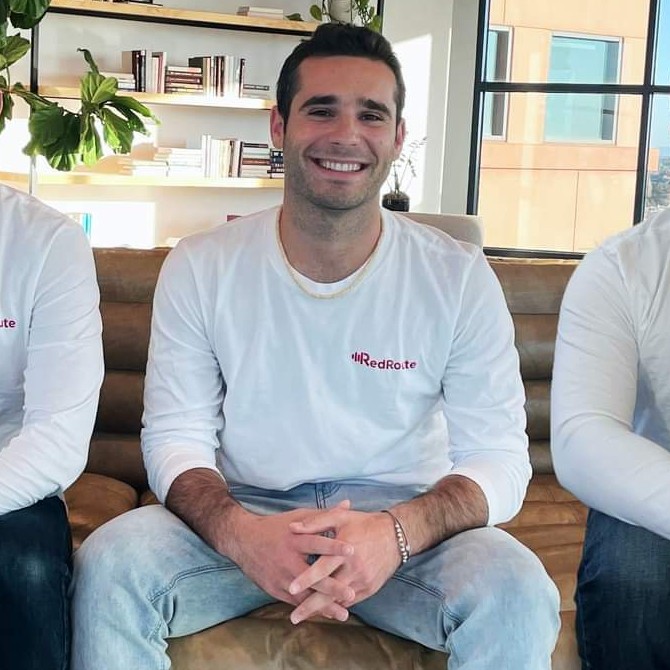
Brian Schiff
